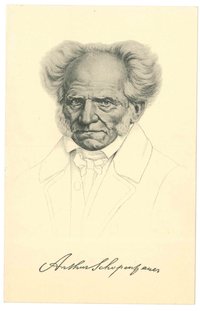
"Arthur Schopenhauer (/ˈʃoʊpənhaʊ.ər/;[16] German: [ˈaʁtʊʁ ˈʃoːpn̩haʊ̯ɐ]; 22 February 1788 – 21 September 1860) was a German philosopher. He is best known for his 1818 work The World as Will and Representation (expanded in 1844), wherein he characterizes the phenomenal world as the product of a blind and insatiable metaphysical will.[17][18] Proceeding from the transcendental idealism of Immanuel Kant, Schopenhauer developed an atheistic metaphysical and ethical system that has been described as an exemplary manifestation of philosophical pessimism,[19][20][21] rejecting the contemporaneous post-Kantian philosophies of German idealism.[22][23] Schopenhauer was among the first thinkers in Western philosophy to share and affirm significant tenets of Eastern philosophy (e.g., asceticism, the world-as-appearance), having initially arrived at similar conclusions as the result of his own philosophical work.[24][25]" - (en.wikipedia.org 08.11.2019)





